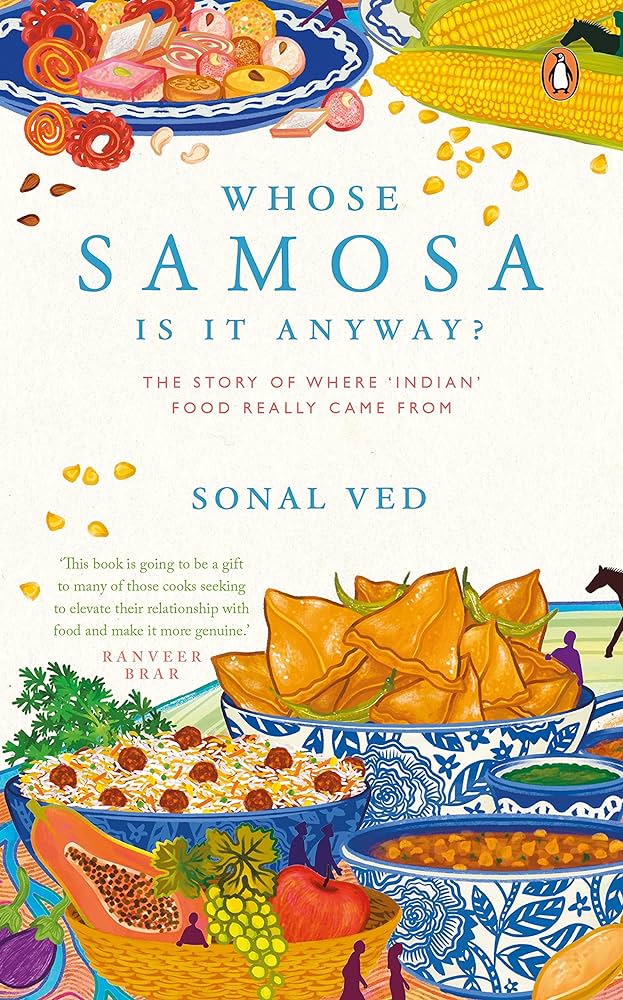Whose Samosa is it Anyway?: The Story of Where ‘Indian’ Food Really Came From
Written by Sonal Ved
Publication date: September 26, 2023
Publisher: Penguin Random House India Pvt. Ltd.
248 pages
ISBN: 978-0143460060
Having recently returned from a winter trip to India that included jaunts to Delhi, Uttar Pradesh, Rajasthan, Karnataka, and Tamil Nadu where we ate pav bhaji, kachori, bisi bele bath, rabdi, idli, dosa, and so much more, I was eager to dig into Sonal Ved’s Whose Samosa Is it Anyway?: The Story of Where ‘Indian’ Food Really Came From, a historical exploration of Indian sub-continental cuisine. Many of us who identify as having Desi heritage understand that labeling our cuisine as simply “Indian” does not fully capture the vastly diverse and distinct ways of cooking across the South Asian geographical and cultural terrain. For example, in the Northern region of India, the cuisine features several types of bread including naan and roti, as well as cream-based curries; in the South, you’ll find more rice-based dishes including dosa and idli, and tangy lentil-based stews such as sambar and rasam that feature tamarind. Ved draws on her background as a cookbook author and food journalist for such publications as Harper’s Bazaar India and Vogue India to trace the intricate history of India’s culinary origins, as well as dispel any previously held notions about the provenance of commonly used ingredients in Indian cooking such as red chillies and tomatoes–these were actually brought to India by the Portuguese in the 16th century.
Whose Samosa Is It Anyway? is chronologically organized into five chapters (not including the lengthy introduction) beginning with the Indus Valley civilization followed by sections on religion, royalty, traders and conquerors, and finally concluding with how political changes, such as the 1947 Partition of India, impacted cooking and the food industry on the subcontinent. At well under 300 pages, Ved packs a lot of information into her book but some sections are extremely dense while others are given short shrift. Additionally, the Indus Valley civilization section seemed more suited to a text on archaeology, rather than food history; the religion chapter primarily focuses on Vedic society (which shaped Hinduism, Jainism, and Buddhism), but says very little about the other major faiths in India and their influence on culinary practices.
The section on Indian royalty covers the Mughal and Maratha empires of the 16th and 17th centuries, and ancient kingdoms including the Mauryan, Pallava, and Chola dynasties, providing fascinating evidence into how royal culinary traditions eventually spread outside the subcontinent due to overseas trade. This particular section made me think of the incredible Indian television show, Raja, Rasoi aur anya Kanhaniyaan (“Kings, Kitchens and Other Stories”), which covers various types of royal cuisines all over the subcontinent–I highly recommend this series, currently viewable on Netflix.
But unlike the book’s introduction where Ved’s own voice comes through in anecdotes about her Sindhi school chum’s delectable tiffin, the rest of the text is very expository, jumping from one historical tidbit to another in a dizzying fashion, with little critique or in-depth analysis. And, beyond a cursory description of Mahatma Gandhi and Rabindranath Tagore’s relationship with food and politics, Ved doesn’t say more about contemporary India, which feels like a missed opportunity. Still, I think Whose Samosa Is it Anyway? is a compelling read for those of us seeking a nuanced understanding of India’s gastronomic culture.
Review by Lalitha Nataraj, editing assistance by Charlotte Roh.
Book reviews and author interviews featured on APALAweb.org are reflective of the reviewer and interviewer only and are conducted separately from and independently of APALA and the APALA Literature Awards Committee and juries.

